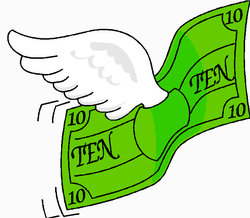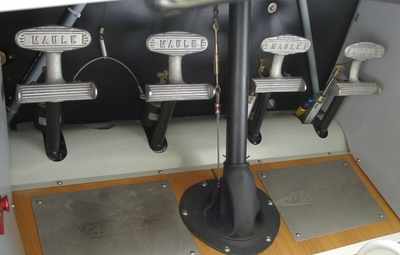We caught up with Jim Lauerman at Oshkosh, and he had a number
of interesting observations -- and a few tips -- for us. Jim is
AVEMCO Insurance's Chief Underwriting Officer, and he wanted, right
away, to dispel a myth. "I'd bet this next paycheck that AVEMCO is
still the largest underwriter of homebuilt aircraft. We're writing
almost all the homebuilts -- not the super-high-performance ones,
but most of the popular ones, even some one-offs. The impression
was that we somehow got out of the homebuilt business -- that's not
true, obviously."
It's about giving people what they need, and staying in
business.

Mr. Lauerman reminded us, "We're a publicly-held company. We
want to write homebuilts -- we want to write all the business we
can -- but we have to do it profitably."
So, how do you evaluate a new design?
The approach should not surprise anybody. Jim said, "On a new
design, we'll do our best to categorize it -- wing loading,
V-speeds, and so on -- and then we monitor it. On a one-off, we
typically write third-party liability only." That third-party
business, he said, "is more-closely related to the aircraft, than
to the pilot, for that type of coverage. It's kind of like our
non-owner insurance."
Do renters need insurance?
"I really wish more people knew about non-owner insurance,"
Lauerman said. He ran a forum at Oshkosh, early in the morning.
"There's a lot of enthusiasm about this -- we're hitting a resonant
chord." Sixty-five people were there, at 8:30 in the
morning. "Pilots don't know -- there's 300,000 renter-pilots
who don't carry renters' insurance."
How pilots get in trouble (part 1)
"Most pilots," he explained, "think that the FBO's insurance
covers them. Sure -- but after the FBO's insurance company pays the
FBO, they have subrogation rights -- they can come after the pilot.
The pilot stands to lose a lot, unless he is insured."
Non-owner insurance is inexpensive; you buy it by the year, "and
it covers you in any airplane that meets the policy. [Twins,
turbines, and a few other types are generally excluded --ed.],"
Lauerman told us. "The policies are priced, based on the coverages
purchased, regardless of the pilot. Based on the coverages chosen
[AVEMCO also has the most-popular options prepackaged --ed.], the
pricing can be well under a dollar a day." Part of the low cost is
the program's ease of administration; policies are available on-line, 24/7.
...and the best thing about this?
"The best thing," Lauerman told us, "is that all these policies
come with unlimited legal defense, by real
aviation insurance attorneys -- even to defend your personal
expenses." He put the program in perspective: "Buy as much as you
want, but get something -- your first hour of attorney's
fees can easily cost more than your coverage for a year."
 If you think you won't get snared,
think about this: particularly since September 11, FBOs have been
hit with sometimes-enormous premium increases. One strategy they
have taken is to increase their deductibles. If you bend their
plane, and they have to pay, say, $5000 deductible, you'll probably
get a call from your FBO's lawyer, to cover that $5000, as well
as loss of use of aircraft and the inevitable 'diminution of
value' of the airplane you bent.
If you think you won't get snared,
think about this: particularly since September 11, FBOs have been
hit with sometimes-enormous premium increases. One strategy they
have taken is to increase their deductibles. If you bend their
plane, and they have to pay, say, $5000 deductible, you'll probably
get a call from your FBO's lawyer, to cover that $5000, as well
as loss of use of aircraft and the inevitable 'diminution of
value' of the airplane you bent.
Sorry, your individualism isn't your only insurable
quality.
"Everybody's an individual," Jim readily admitted, "but not
every policy is individual, to that degree. We take you and your
qualifications and record, and put you into a class or category,
and rate that class." Insurance is about spreading risk, after all.
"Everyone thinks he's an individual, but you've got to do the math.
We have to determine what's a good risk and what's a bad risk -- as
a class. We don't look at just one year, either. After a while, the
numbers get more solid." Remember -- the idea isn't to raise rates;
in fact, it's to keep rates as low as possible, while still
providing coverage, and a reasonable profit for the company.
Just like the parents in the fictional Lake Woebegone (MN), all
pilots consider themselves 'above average.' The numbers are better,
when it comes to rating groups of people, than individual
assessments. "What tends to happen a lot in this industry," Jim
noted, "is that so many insurers think like pilots -- reacting to
the last bad news they heard, or basing large-scale decisions on
their own personal experiences. Numbers aren't perfect, but if you
don't use them, you're left with personal bias, your limited
personal experience, and so on. That's not good business: it's
gambling, not insurance."
AVEMCO is giving away money. Well, just about...
As ANN told you last Spring, AVEMCO teamed up with Martha and
John King in a new program, in a sort of new
direction for King's offerings. The program, designed to educate
pilots to think (there is no written test at the FAA for
that), is designed to keep us from getting behind the airplane or
the weather, as we blissfully operate systems. "It's too early to
tell if that program has improved safety, but we believe that it
will," Jim said. "We can't run numbers yet -- it's too early -- but
we know that it can't hurt. We also know that it's the right thing
to do."

AVEMCO is reducing rates by 5% for graduates of that King
course; it also offers additional discounts to pilots who complete
additional performance regimens -- a tailwheel endorsement, a float
rating, or any number of other enhancements.
Jim understands: "Pilots complain about insurance
rates. Insurance just takes the past to predict the
future. What we're doing with the Safety Rewards Program is to change the
actual numbers, so that 'the past' a few years from now will be a
more-attractive picture than 'the past' does now. We might even end
up with lower rates."
This program is more than AVEMCO's private crusade. Lauerman
told us, "We are, of course, trying to do good business; but of
course we're also trying to impact, even redirect, the industry. I
believe we, as an industry, haven't given people the tools to be
safer." [To that end, AVEMCO has a special section on their
website, with some 'this really happened' scenarios. We can learn
from them --ed.]
How pilots get in trouble (part 2)
As a guy who looks at every single claim submitted to AVEMCO ("I
really do that -- even if it's just a quick scan," Jim said),
Lauerman sees a lot of things emerge as patterns.
"There are certain things -- VFR into IMC -- that are
no-brainers. Everybody knows about those... There's a few things
that we hardly ever think about, though... Loss of directional
control on the runway -- this is the most-common
claim we see every day. Inability to use the rudders must
be 30~40% of claims dollars." They're important, though: "You don't
hear about these; most of them don't even get into the NTSB
database -- but you're talking about millions and millions of
dollars."

What's the root problem? "People just don't know how to use
their feet. Think about this: God gave us feet to counteract
adverse yaw."
 Senator Pushes FAA to Accelerate Rocket Launch Licensing
Senator Pushes FAA to Accelerate Rocket Launch Licensing Classic Aero-TV: RJ Gritter - Part of Aviations Bright New Future
Classic Aero-TV: RJ Gritter - Part of Aviations Bright New Future Aero-FAQ: Dave Juwel's Aviation Marketing Stories -- ITBOA BNITBOB
Aero-FAQ: Dave Juwel's Aviation Marketing Stories -- ITBOA BNITBOB ANN's Daily Aero-Linx (10.27.24)
ANN's Daily Aero-Linx (10.27.24) ANN's Daily Aero-Term (10.27.24): Clearance Void If Not Off By (Time)
ANN's Daily Aero-Term (10.27.24): Clearance Void If Not Off By (Time)






